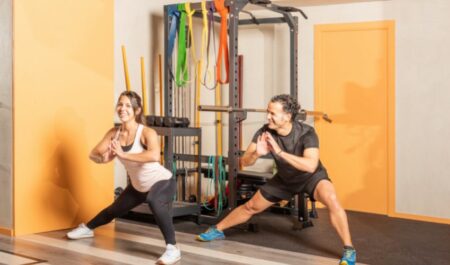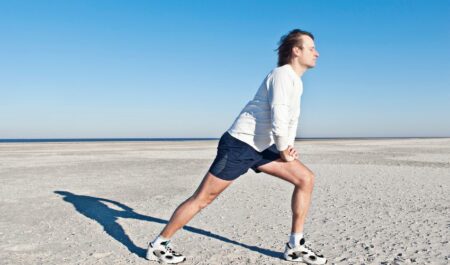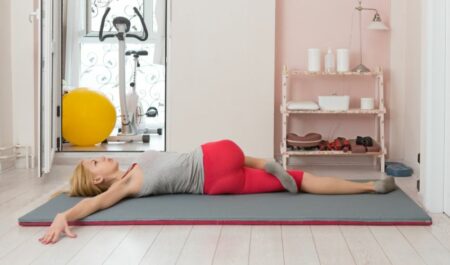Stretching is an important component of practically any type of workout, but it is especially important for runners. Even going for a brief jog can work your muscles, and the majority of medical professionals advise stretching both before and after exercise as a preventative measure.
Skipping your post-workout stretch might, over time, cause your range of motion to diminish. This is due to the fact that exercise can lead your muscles to become shorter. By maintaining their flexibility by stretching, the muscles in the body are able to keep moving through their complete range of motion.
It is also recommended by the majority of medical professionals that you warm up before stretching and running. When the muscles are warmed up, they are better able to respond to the strain that is placed on them by the body.
To start the blood pumping through the body and prepare it for activity, a simple warm-up routine can consist of walking for five to ten minutes.

The Difference Between Static And Dynamic Stretching
Static stretching and dynamic stretching are the two primary classifications of stretching that are typically used.
To perform a static stretch, you first move a joint or muscle as far as it will go, and then you hold it in that position for a set amount of time. Take, for instance:
- Reaching down to touch your toes and then holding that position for a predetermined amount of time once you’ve gone as far as you can in that direction.
To perform dynamic stretching, you must move your joints or muscles in predetermined motions for a predetermined number of repetitions. For instance:
- Before going for a run, you should perform 10 to 15 leg swings, swinging each leg back and forth.
In the world of fitness and research, there has been some debate on the type of stretching that should be done before an exercise that is considered to be the most beneficial. However, it appears that the majority of people agree that dynamic stretching is most beneficial before a run, whilst static stretching is most beneficial after a run.
10 Beneficial Stretches To Do After A Run.
Here is a list of the 10 most important muscle groups for runners, as well as some stretches that can be done after a run to help maintain those muscles healthy. If you are seeking for a useful pre-workout stretching routine, you can find one below that we put up for you.
Note: Because there are so many various types of static stretches, if one of these examples doesn’t work for you or if you’ve found other static stretches that provide superior support, feel free to use those instead. There are so many different sorts of static stretches out there.
Quadriceps Muscle Workouts.
Your quadriceps femoris muscles cover the majority of the front and sides of your thighs, which is why they are commonly referred to as your quads. It is especially crucial to stretch your quadriceps if you are going to be running up or down hills.
In Order To Exercise Them:
- Maintain an erect stance and use the hand that corresponds to the opposite leg to drag it behind you.
- Pull your shin toward your thigh while tucking your pelvis below you.
- As you perform this stretch, make sure that your knee is oriented in a downward direction to protect the knee joint.
- Maintain this position for at least thirty seconds, and then transfer sides.
You might also use a chair to help you maintain your balance. You should be able to feel this stretch at the front of your thigh, as well as all the way down from your hip to your knee.
Hamstrings Muscle Workouts
Your hamstrings are the muscles that run along the back of your thighs, beginning at the hip and ending just above the knee. The majority of the benefits of this stretch come from its effects on the hamstrings, but it also has positive effects on the adductors.
Regarding this stretching;
- Take a seat on the floor and stretch out your left leg.
- If at all feasible, bring your right foot up close to your inner thigh, so that it can make contact with the upper part of your left leg.
- Lean forward as if you were reaching for your toes, but be careful not to curve your back or your waist as you move toward your left foot.
- Maintain the hold for at least thirty seconds.
- Perform the same motions with the other leg.
You should be able to feel it running the length of the back of your leg, from your knees all the way up to your buttocks.
Calf Muscle Workout

After you’ve gone for a run, one of the most important areas to focus on is the back of your lower legs, specifically the calf muscles. Inadequate calf stretching might increase the likelihood of pain and injury.
To Stretch The Muscles In Your Calves:
- Keep your right foot behind your left one while you stand.
- You should lean forward on your left leg while maintaining a straight position with your right leg.
- Take care not to bend your right knee, and ensure that your right foot remains firmly planted on the ground while pointing in a forward direction.
- Maintain a straight back and try to sustain this position for at least thirty seconds.
- Perform the same motions with the other leg.
- Put your hands up against a wall and push into it as an alternative move or if you find that you need assistance maintaining your balance.
This stretch ought to be felt anywhere from the back of your knee all the way down to your ankle.
Iliotibial Band Workout
Although this stretch technically lengthens your tensor fascia latae, which is an important muscle in your hip, it is commonly referred to as the iliotibial (IT) band stretch because it can also help with your body’s iliotibial band, which runs on the outside of your thigh between your hip and shin. This band is located on the lateral aspect of your thigh.
Runners who don’t exactly have the right training routines and runners who compete in long distance events are often the ones that damage themselves in this region.
In Order To Perform This Stretch:
- Take a position close to a wall or another stable object that you can utilize to help you maintain your balance.
- Put your right ankle in front of your left ankle and cross them both.
- While maintaining your balance with your right arm, reach your left arm over your head with a stretched out position.
- You should raise your right arm and reach up and above your head while stretching toward your right side.
- Maintain this position for at least thirty seconds, then switch legs and repeat.
You will feel the stretch in your left leg when you bend toward the right and cross your left ankle behind your right ankle. This position will cause your left leg to become longer.
Psoas Muscle Workout
The psoas muscle is located in the front of your spine and connects the lower back to the upper thigh. It is pronounced “so-az.”
To Stretch Out This Muscle In Particular:
- Put your right knee in front of your left knee and bend both knees to a right angle.
- When you feel a stretch coming on, squeeze your glutes, tuck your pelvis under, and move your hips forward as far as you can.
- Raise your left arm above your head and slowly stretch towards the right side of your body.
- While you are extending to the right, you should also slightly open your torso to the left.
You need to feel the stretch on the front of your hip on your back leg where it is attached to your back foot.
Gluteus Maximus And Piriformis.
The piriformis, which is a deep muscle that extends from your sacrum to your thigh bone, gets lengthened as a result of this stretch.
It also extends the gluteal muscles, which is beneficial for runners because the gluteal muscles play an important part in running. Improving your running performance requires you to work on both strengthening and extending the muscles in your buttocks and thighs.
In Order To Perform This Stretch:
- Position yourself so that you are lying on your back with your knees bent and your feet flat on the floor.
- Your right ankle should be crossed over your left knee.
- Take hold of the area behind your left knee, and raise that knee up to your chest.
- Maintain this position for at least thirty seconds, and then transfer sides.
You should be able to feel the stretch in the buttocks and the back of your thighs.
Adductors Muscle Workouts
The adductor muscles are a collection of muscles that are found in the inner thighs and go from your pelvis all the way up to your thigh, and in some cases, all the way down to your knee. They are also known as the “thigh adductors.”
Adductor Stretching Consists Of The Following Moves:
- Take a wide stance by standing with your feet as far apart as possible.
- Lean to the right and bend your right knee until you feel a stretch. Do not move your left leg at any point during this exercise.
- After holding this position for thirty seconds, turn sides.
You ought to feel a stretch in the innermost part of your thigh.
Spine Workouts

Surfaces that are more difficult to run on, such as sidewalks, can exert additional stress on the spine, which can lead to discomfort and tightness in the back.
To Extend Your Entire Spine:
- Position yourself so that you are lying on your back with your arms extended out to the side.
- Make a knee bend with your right leg, bringing it in toward your chest.
- While maintaining contact with the ground with your right arm and shoulder blade, let your right knee to drift ever-so-slightly to the left. When you feel a stretch, you should stop.
It ought to feel like there’s a stretch in your back.
Lower Back Muscle Workout
A runner’s attention should also be paid to the region of the body that is located in the lower back. Stretch your lower back by doing the following:
Place Yourself On Your Back.
Take hold of both of your knees and bring them to your chest until you feel a stretch in your hamstrings.
Maintain this hold for a minute.
